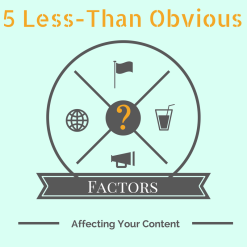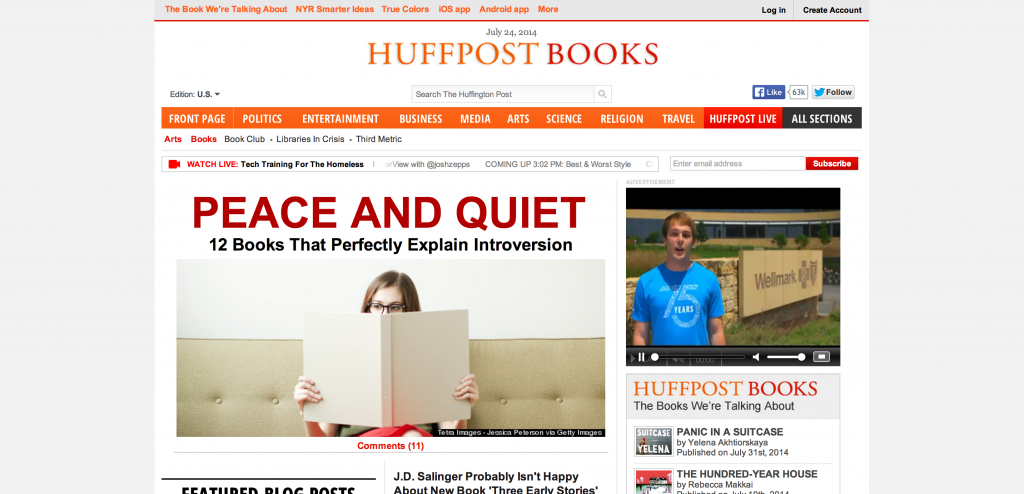 As a content creator, your lens of focus is often fixated squarely on the content itself. Does this sentence make sense? Does this video capture our brand sentiment? Is this infographic well-cited? That’s not to say that your attention isn’t warranted; creating engaging, attention grabbing posts is no easy task.
As a content creator, your lens of focus is often fixated squarely on the content itself. Does this sentence make sense? Does this video capture our brand sentiment? Is this infographic well-cited? That’s not to say that your attention isn’t warranted; creating engaging, attention grabbing posts is no easy task.
What you probably don’t realize is that while you’re crafting copy that converts, your visitors are looking at your circa 1990’s aesthetic and making pretty profound judgments about your company. That’s right; despite your most informed efforts to create quality content, your readers are potentially more distracted by your font size or sharing buttons than the words you’ve chosen.
These days, publishing successful web content is about taking a holistic approach; framing high quality content in a high quality frame at the right time of day, and in conjunction with appropriate current events. Based on these often-overlooked factors, your blog can be either a port of call for engaged customers, or a ship passing in the night.
Web Design
Modern users are savvy; they’ve experienced several websites, learned what good design looks like (even if they can’t explicitly identify what makes the design “good”), and they’re unwilling to accept anything less. In fact, as much as 52% of visitors will not return to a blog because of its color or design.
In their interaction, they’ve experienced engaging designs and organized layouts that are both aesthetically pleasing and structurally functional. The Huffington Post, for example, utilizes a hierarchy of font sizes and weights to guide the eye down the page, organizing content in an visually digestible grid and linking to related stories. Additionally, distinct content categories are delineated by color, help further divide content into distinct groups.

What Huffington Post demonstrates through this design is a clear understanding of the importance of framing quality content with strong web design. The typographic layout helps guide user attention with little additional prompting or guidance. The grid layout organizes pieces in an easily and immediately understandable way. Finally, individual colors help divide content along contextual lines, evoking a psychological response commensurate with the topics discussed.
Of course, these principles don’t apply specifically to news sites. Many of the principles exhibited here are fundamental to a well-designed site. The key lies not in replicating these concepts whole-cloth, but in adapting them to your business and blog.
Your color and design speak volumes about your brand. Blue, for example, offers a calming, professional, and official look, while green suggests growth, money, or eco-friendly values. A more ornate (without being cluttered) layout evokes sentiments of luxury, while a more spartan layout evokes a more modern and technologically sophisticated feeling.
Even more concrete factors can affect site traffic; if your navigation is confusing, if your viewers can’t find relevant articles after enjoying their first read, your odds of turning a one time visitor into a repeat reader diminish greatly. The above example serves related information to readers at the bottom article, guiding their experience from one piece to the next and investing them in the process.
For your business, there are two powerful ways to improve your design: professional help and an informed DIY approach.. Budget permitting, a designer with strong credentials can easily guide you through the process of improving your site, both aesthetically and structurally. For more frugal business owners, this may seem like a waste of money. However, some of the most highly traversed websites were developed using both fundamental and sophisticated design principles; information that requires years of training and education to glean.
If you’re still skeptical of the value of a designer, or your available budget is limited, there are simple ways to improve your design without emptying your coffers. First, consider examining high-quality resources for a cursory design education. Books like HTML and CSS by John Duckett offer basic information to those without prior experience, while websites like Hackdesign.org can provide both a theoretical and practical foundation of design knowledge.
Then, when tweaking your site aesthetic, consider some basic rules of thumb:
- Less is more
- Symmetry is attractive
- Grids are functional and readable
- Fonts should be simple
- Pictures should be high-resolution
Even just these basic points will help turn a mid-90’s artifact into a more modern, elegant site that reads well and improves your brand perception.
The important thing to remember is this: your site design matters. If your content fails to retain readers, take a look at your organization, structure, and aesthetic. Odds are that your look could use a little update.
Current Events
It should go without saying that, in the event of an oil spill in the Gulf of Mexico, your guest post about the coast’s best vacation spots is probably going to struggle. However, this catastrophe simultaneously raises the stock of articles on oil rig safety, the environmental impact of oil spills, and advancements in solar power.
Our collective, online consciousness is inexorably influenced by current events. Google News drives volumes of traffic on a regular basis, with as much as a quarter of these visitors returning to the referred website in the ensuing week.
If you’re a B2C company, cultural and seasonal trends are likely to influence which posts find success. If you’re a B2B company, your authority will be called upon to shed light on a “scary” or far-reaching circumstance. Time your stories with news events, and avoid posts that run outside the narrative.
The Reading Experience
Your business markets to an audience. In general, you’re aware of the lifestyles, business needs, and technical knowledge of your readers. However, what’s lost in this demographic profile is the actual physical capability of your reader; namely, their capacity to consume the content you produce.
The physical layout and font of your content are factors that often go ignored at the peril of conversion. At 40, only half the light reaches the human retinas that did at age 20. At age 60, that figure is 20%. Furthermore, small fonts and lack of contrast are the number 1 complaints of web readers.
If you or your readers can’t consume your content without squinting or struggling, your business is missing out on valuable repeat visits. Opt for larger font sizes and remove any background texture that may obfuscate the content text. Additionally, utilize serif fonts for body copy, as these help guide the eye along the text, allowing for an easier reading experience.
Timing
While news currents can help dictate the direction of your content, the ebb and flow of readers’ lives greatly influence the impact of pieces on a daily and weekly basis. According to the content scheduling experts over at Buffer, engagement with blog posts rises 18% on Thursdays and Fridays and 32% over the weekends as readers find more time to read and interact.
This example demonstrates a simple fact that many marketers still do not understand: the user is more than a pair of eyes and a wallet. In an average day, your “target consumer” wakes up at a particular time, engages in a routine based on their location, occupation, work environment, hobbies, and family life, and utilizes a myriad of devices to accomplish a myriad of goals.
In this context, several questions come to mind. How are readers reaching our site? What device are they using? How big is the screen? Why are they reading our content and how does it further their goals or aspirations in life? How much time do they have available to read our content? Can they listen to audio in their regular viewing environment?
As you can see, when one examines the consumer with this level of detail, the picture can become quite complex. Buyer personas, a tool that endeavors to capture and comprehend the day-to-day habits of your regular consumers, offer a more robust picture of reader availability, particularly when used in conjunction with various article performance metrics.

So how does this affect your content? Clearly, if your reader cannot listen to your newly released YouTube video at work, then your content is destined to miss the mark. If your posts are published after your reader has left the home and prior to their lunch break, it is likely that they will be lost in the ever-churning media shuffle.
If your posts are performing poorly, there are several methods by which you can analyze and optimize your timing. Begin with your buyer persona. If you don’t have developed buyer personas, create them. Identify the times of day and devices used when the bulk of your audience views your blog. With this information, scheduling posts based on media type and promotion platform (Facebook, Twitter, Google+, etc.) is a simple matter of understanding where your readers reside and what kind of media they can consume during their day.
Less optimally, but still useful, your raw analytics can help point to down-periods and high-traffic times. Publish several pieces over the course of a day, or try promoting the same piece at various times during the day and continue to do so for several weeks. With this data set, look for trends in performance, keeping in mind that a large sample size is needed to correct for popular or unpopular topics and other modifying factors.
Utilize both of these approaches in conjunction to further fortify your knowledge of your audience. With this level of insight, any publication outside of peak hours becomes a silly exercise.
Tone
If you’re a new writer, or a writer from a particular vertical, certain writing habits may become ingrained in your process. Basic concepts like quality and structuring are universal, but some idiosyncrasies do not translate well across industries or topics.
Your company, provided your marketing department has done their part, should have a prescribed personality, presence, and brand. Each of these elements, combined with the predilections of your audience, can and should dictate the tone of your articles. For many businesses, this comes in the form of a “style guide”; a fully developed document that outlines the graphical and verbal signature of your company in all publishing contexts.
As mentioned, the tone you strike depends as much on your vertical or industry as it does on your corporate identity. In fact, content marketing as a practice serves two distinct purposes based on your target audience.
For B2B businesses, the goal of content marketing is to establish authority. The concept is simple: when your customers speak the same language and carry the same level of knowledge about the industry as you, anything you can do to establish your company as an industry leader is valuable. Therefore, if, for example, your company is publishing an article about industrial safety or SEO best practices, speak with an air of authority, confident and without fluff, and actively answer questions with evidence to legitimize your assertions. Doing so both leverages the needed information for other industry members to make an informed decision, and does so in a manner that legitimizes your corporate reputation.
For B2C businesses, the goal of content marketing is to capture a lifestyle that resonates with your customer and provide value in their life. Goods from apparel to cookware to laptops are sold with one question in mind: how does this affect the consumer’s life. For this reason, content that demonstrates or suggests a life or circumstance enriched by your product will not only help convert sales, but will help bring brand and consumer closer together. A clothing company, for example, may publish a look book for this season’s fashions featuring photographs of happy, smiling, fashionable people, encapsulating the consumer experience and allowing readers to envision themselves in the same scenarios, happy and fulfilled.
Marrying your tone with the identity of your company and the goals of your blog is paramount to success. If a cursory look at your copy fails to capture the sentiments mentioned above, it may be time to re-examine, re-align, and re-buff your blogging diction.
Content marketing is about so much more than content; it’s about providing a complete package that delivers timely, relevant value and fosters conversion. Pay heed to the design, tone, and timing of your content, and let your analytics prove their worth.



